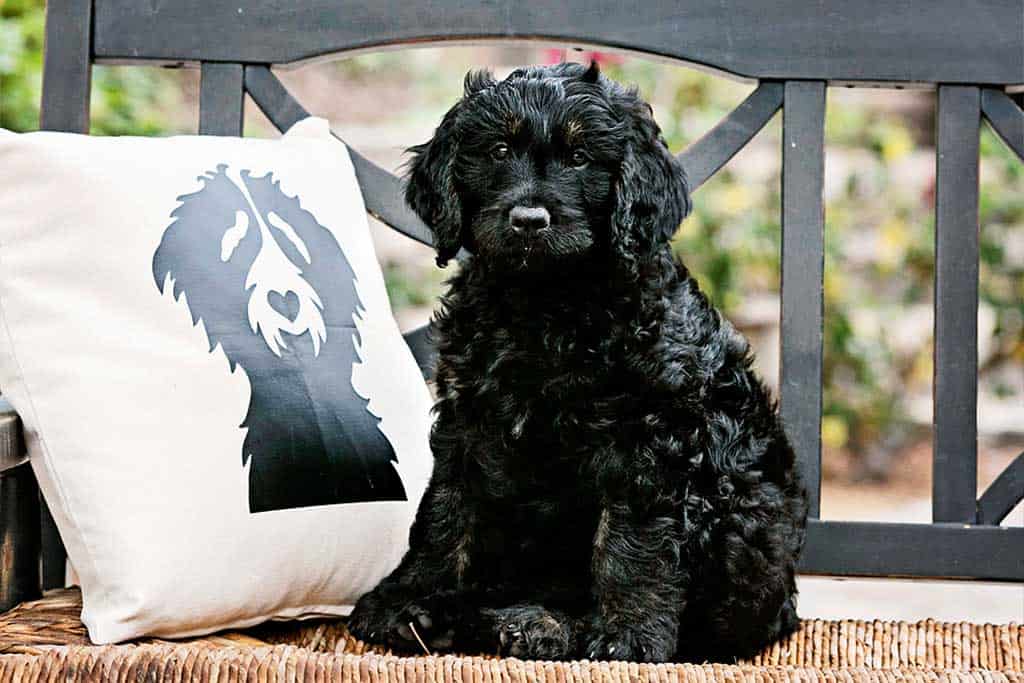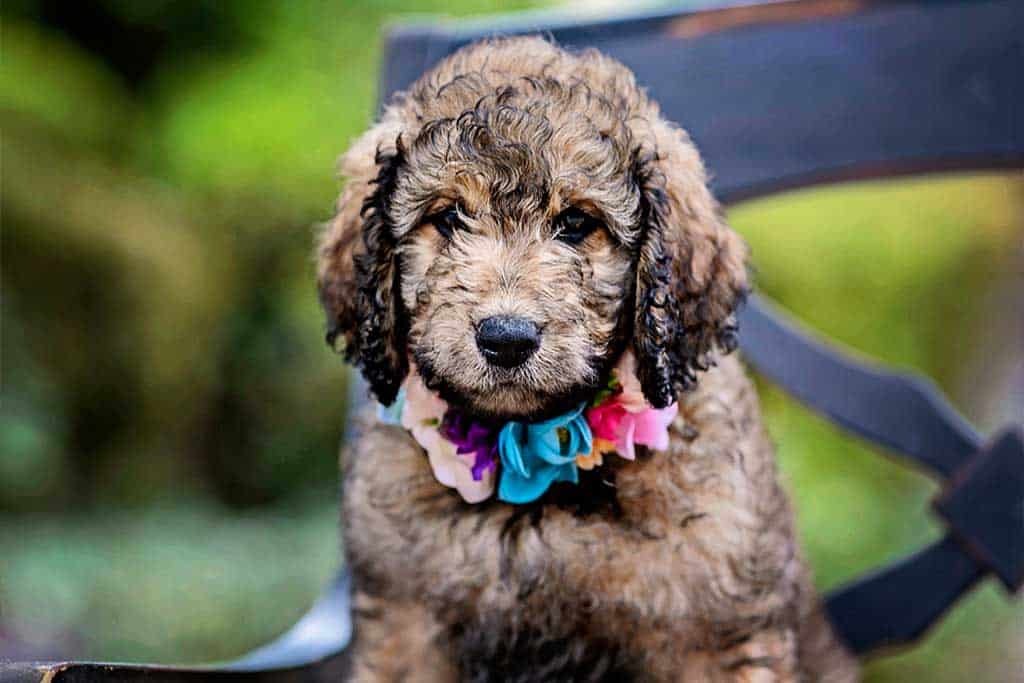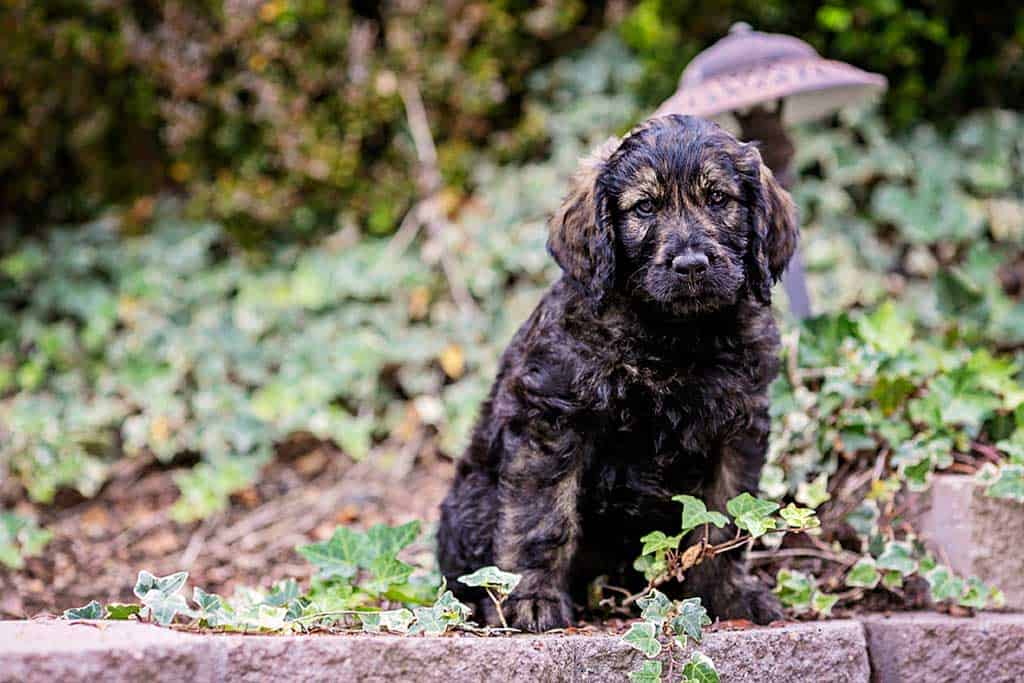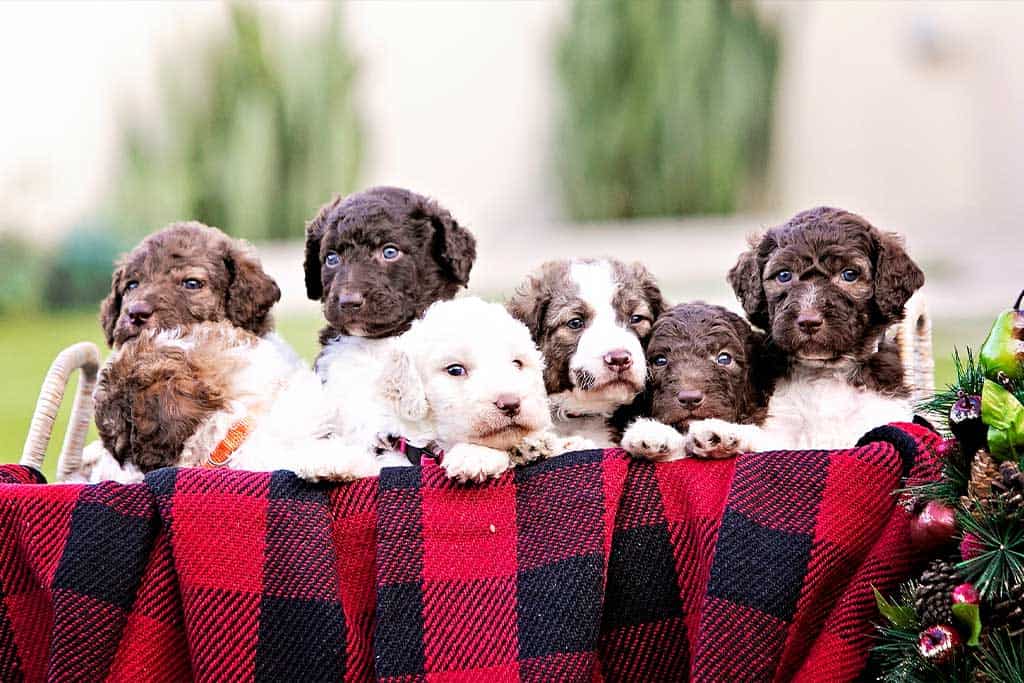Goldendoodles are very similar to Labradoodles, but they are not the same breed. They are actually created by cross-breeding Golden Retrievers and Poodles to create this hypoallergenic family dog that loves playing and being outdoors.
We took it upon ourselves to explore the many different types of Goldendoodles out there in order to provide you with an extensive list of all the different types of Goldendoodles and what makes them unique from one another. From standard doodle to miniature doodle, from black to white, and from long-haired to short-haired, each type of Goldendoodle has its own unique characteristics and personality traits. If you’re considering adding a Goldendoodle to your family, it’s important to know about the variety of options available so you can find the right type of dog for your lifestyle.
The history of Goldendoodles and their advantages
Goldendoodles are mixed-breed dogs that possess many coat textures and colors. The coat’s appearance can range from smooth to shaggy, with loose or tight curling. The majority of goldendoodles have blond or cream-colored coats. Goldendoodles often weigh around 50 to 80 pounds as adults.
The objective of breeding such a combined dog was to create a dog with a coat that was less likely to cause allergic reactions in allergy patients and a nice demeanor so that it might serve as a service dog for the blind who suffer from allergies.
By combining poodles with other species, producers hoped to gain the non-shedding fur of said poodle as well as certain attractive traits from other types of dogs they had been crossed with. However, genetic factors never assure that the progeny will acquire the poodle’s coat.
In the case of breeding poodles with golden retrievers, producers hoped to achieve the best of the two: a purebred dog that does not shed, getting this from the poodle, and the amiable demeanor of the golden retriever. Due to reports that Goldendoodles are hypoallergenic, Goldendoodle gained significant popularity in the 1990s. Hypoallergenic has become a buzzword in the world of dog breeding. However, claims that dogs are completely hypoallergenic should be treated with caution.

It is commonly asserted that hypoallergenic canines are less prone to provoking allergy symptoms in allergy patients. Typically, the breeds listed in this group are ones that shed less.
However, the difficulty with this approach is that dog sensitivities are not solely caused by dog fur. Proteins present not just in a pet’s fur but also in its spit, urine, hair roots, and the skin layers that are routinely shed during the day can pose a health risk to allergy sufferers.
In addition, doctors advise that hair from dogs or fur can accumulate dust, mold, mildew, and other environmental pollutants known to cause allergic reactions. This means that even hairless dogs, like the Mexican hairless dog, have the potential to provoke allergic reactions.
Different variations of the Goldendoodle
There is no assurance that all Goldendoodles will have the same size, coat structure, color, or attitude due to the fact that their parents are purebreds of two distinct breeds.
Due mostly to the Poodle gene pool, Goldendoodles can be found in a variety of sizes, shapes, and colors. Standard Poodles are twenty-two to twenty-seven inches tall, Miniature Poodles are thirteen to fifteen inches tall, and Toy Poodles are eleven to thirteen inches tall.
They are available in a variety of colors and styles (ten inches and under). Consequently, Goldendoodles typically weigh between forty and one hundred pounds, while Poodle mixes weigh between thirty and forty pounds and mini goldendoodles weigh between fifteen and thirty pounds.They can sometimes be white, red, black, gold, brown, white, gold, or gray, or a mixture of these colors with speckled patterns.
Goldendoodles may have tightly curled hair like their Poodle ancestors, delicate curls, or flattened and straightened hair like Golden Retrievers. Even though they don’t lose fur excessively, they must be combed frequently to avoid matting. Additionally, they require regular grooming since their hair can develop over the eyelids, all around the tail, or between the toes.
What distinguishes the different Goldendoodle breeds?

Goldendoodles are available in a variety of sizes. Tiny or Mini, Medium, and Large. As per the Goldendoodle Association of the United States, a dog’s final size classification is established at maturity and weighed at the withers.
Goldendoodles will have significant grooming needs. determined by the type of coat, some more so than others. They should be cleaned regularly and trimmed every four to six weeks. Our blog on Goldendoodle grooming contains additional information.
The hair would be wavy to curly, rather than straight, yet we do observe it. If any shedding occurs at all, it will be small. Most dogs are quite allergy-friendly, although F1B Goldendoodle seems to be the most allergy-friendly.
As a result of their Golden Retriever and Poodle ancestry, Goldendoodles will be incredibly affectionate and sweet. They are quite intelligent and enjoy playing, yet they are also quite gentle. They are wonderful family pets.
They make excellent therapy dogs, but they can also serve as support or guide dogs. Nonetheless, for a happy, healthy dog, movement is a limiting factor. They thrive on adversity and make excellent agility dogs. They thrive best in households with active, outdoor-oriented family members. Daily exercise is necessary. Lack of activity can lead to undesirable behaviors such as excessive digging, gnawing, barking, or other actions.
Given the form of the progenitors, you will need to keep an eye on the puppies’ chewing habits and ensure that they are trained not to chew on people from the start. Teaching children that it is acceptable to play with their toys is an excellent strategy.
Due to their nature, they do not make suitable apartment pets. They require outdoor activity and plenty of space to play. Due to their high activity level, this is really the only disadvantage of not using them as service or guiding dogs.
Different Goldendoodle types chart and genetic compositions
| f types of goldendoodles | First parent | Second parent | Percentage of golden retriever genes received | Percentage of poodle genes received |
| F1 Goldendoodle (first-generation) | Golden retriever | poodle | 50% | 50% |
|
Fist generation backcross |
F1 goldendoodle
|
Poodle |
25 | 75 |
|
F1BB Goldendoodle |
F1B Goldendoodle | Poodle | 12.5 | 87.5 |
|
F2B Goldendoodle (second-generation backcross) |
F1 goldendoodle
|
F1 goldendoodle
|
50 | 50 |
| F2B Goldendoodle (second-generation backcross) | F1 Goldendoodle | F1B Goldendoodle | 37.5 | 62.5 |
|
F2B Goldendoodle (second-generation backcross) |
F2 Goldendoodle |
Poodle |
25 | 75 |
In most cases, the differences between the Goldendoodle puppy’s parents, also referred to as “generations,” will determine the sort of coat that the Goldendoodle puppy possesses.
The various varieties of Goldendoodles can be broken down into the following different generations of goldendoodle:
F1 Goldendoodles

First-generation Goldendoodles are referred to as “F1,” which is an abbreviation for the basis of the many sorts of Goldendoodles. It is the first generation of a cross between a regular poodle of purebred lineage and a Golden Retriever of purebred lineage.
It’s interesting to note that the genetic makeup of F1 Goldendoodles is not as consistent as one might imagine it would be. They may not necessarily inherit characteristics that are similar to Golden Retrievers and Poodles in equal proportions. For instance, they do not necessarily end up with a coat similar to that of a poodle, and their personalities can range anywhere from that of a calm Golden Retriever to that of a hyperactive poodle.
Because of this, F1 Poodle mixes are not necessarily hypoallergenic as a breed of dog.
F1b Goldendoodles
The term “backcross” is denoted by the letter “b” in the names of the several types of Goldendoodles. “F1b” Goldendoodles are the offspring of the F1 Goldendoodle and a Poodle. This designation indicates that the offspring are 75% Poodle as well as 25% Golden Retriever.
In a general sense, the backcross increases the likelihood that the progeny will also have Poodle fur by a significant amount. As a direct consequence of this, F1b Goldendoodles typically have more curly coats and call for more frequent maintenance. They may also be more likely to inherit more of the Poodle’s characteristics.
F2 Goldendoodles
The term “F2” refers to the second generation of Goldendoodles, which indicates that both of the dog’s parents were F1 Goldendoodles. Their looks might be extremely variable due to the fact that they are a blend of two hybrids rather than two purebreds. As a consequence of this, some dogs might have the appearance of golden retrievers, whilst others have the appearance of poodles.
F2b Goldendoodles
The Goldendoodles known as F2b are a backcross of the second generation. These Goldendoodles are the offspring of a cross between an F1 Goldendoodle and an F1b Goldendoodle. Generally, they are likely to have even more Poodle genetics, with coats that are curly or wavy and less matting than other types of dogs. As a consequence of this, they have a greater risk of becoming more hyperactive and agitated, much like a poodle, and they may require more maintenance.
F3 Goldendoodles of Multiple Generations

Goldendoodles of the third generation, sometimes referred to as F3 Goldendoodles, are the offspring of a cross between two Goldendoodles of the second generation. Because they are of the third generation, it is possible that they have lost some of their “genetic improvement.” This is an inevitable consequence of there being more generations.
FAQ
1. Is the F1 or F2 Goldendoodle superior?
F1 generations tend to have straighter hairs, which gives the owner an easier time while grooming. F2 goldendoodles are often better looking with adverse colors too.
2. What Kind of Goldendoodle is Best?
The first generation of golden doodles are often the best type of goldendoodle, despite their shedding.
3. Which is superior: the F1 or F1B Goldendoodle?
F1b golden doodles have curlier coats and they don’t shed as often as F1 goldendoodles.
4. How Much Do F2 Goldendoodles Cost?
On average, F1 goldendoodles cost between $500 and $2500.
5. Are Girl or Boy Goldendoodles Better?
Male goldendoodles are more relaxed and not as aggressive as their female counterparts.
Conclusion
No matter what type of doodle you’re looking for, you’re sure to find the perfect furry Goldendoodle friend for your family. Whether you want a small or large dog, a hypoallergenic coat, or one that doesn’t shed, there’s definitely a Goldendoodle out there that’s perfect for you. Complete our puppy home application to determine if your home is a suitable match for one of our puppies.
Depending on your lifestyle and preferences, any one of these dogs could be the perfect fit for you. Do your research and take the time to find a breeder you trust before making your final decision. With a little patience, you’ll be bringing home the Goldendoodle of your dreams in no time. So what are you waiting for? Go out and find your new best friend today.




